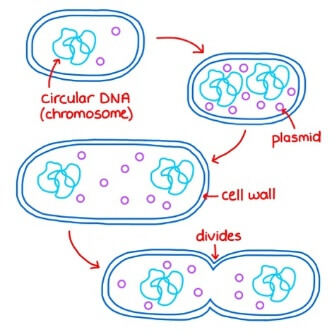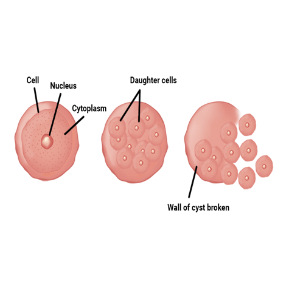Difference between Multiple Fission and Binary FissionThe two varieties of fission are binary fission and multiple fission, both of which result in the formation of daughter cells that are descended from the parent cell. These two methods of asexual reproduction are known as fission. One of the prokaryotes' most popular reproductive strategies is binary fission. In parasite species and protists, multiple fission occurs. In biology, reproduction is often regarded as one of the fundamental ideas. It describes how living things become the species they are and how they differ from other kinds of creatures. As we learn more about different species, we begin to see how they have things in common and how they will persist despite the natural environment's shifting conditions. However, when multicellular cells are involved, cell reproduction is a sign of the expansion and renewal of the cell. In unicellular creatures, when a cell reproduces, it generates a new individual. In multicellular animals, the birth of an offspring is a complex process involving the involvement of multiple hormones. There are two different kinds of reproduction: asexual and sexual. Two-parent cells (a fusion of gametes) participate in sexual reproduction, resulting in the child's reproduction and birth. Contrarily, asexual reproduction involves a single cell that divides its nucleus and subsequently produces progeny. Even at the multicellular levels of fungi, plants, and a few lower animals, as well as in unicellular creatures like archaea, bacteria, and a few other lower animals, asexual reproduction can be seen. Fission budding, fragmentation, vegetative propagation, spore formation, and parthenogenesis are only a few of the many asexual reproduction processes that have been uncovered so far. Here we will examine the two concepts related to sexual reproduction in this instance and how they differ from one another. Both binary and multi-fission have different processes of reproduction. In binary fission, under favourable circumstances, the parent cell splits into two equal and identical daughter cells. In prokaryotes, such as bacteria, it is the most prevalent method of reproduction. In multiple fission, a single parent cell divides into numerous daughter cells under unfavourable circumstances. Binary FissionBinary fission is the name for the asexual reproduction process where the parent body is split or divided into two bodies or a cell. Prokaryotes reproduce mostly via this technique. 
The parent cell is ready for division as a result of the binary process, which caused it to replicate its genetic material (also known as DNA) before being split in half. In order to move the two nuclei in opposite directions, the nucleus containing the genetic material replicates itself. The two nuclei gradually divide, forming two daughter cells when the cytoplasm is split. The daughter cell will thus receive a single copy of the genetic material from the parent cell. The genomes of unicellular creatures don't change since binary fission is a constant process. In unicellular organisms, binary fission occurs in four different ways. They are longitudinal irregular, transverse, oblique, and transverse. Euglena, Amoeba, Paramecium, Ceratium, Clostridium perfringens, Escherichia coli, Bacillus subtilis, B. cereus, Corynebacterium diphtheriae, and others are examples of organisms that divide by binary fission. The process of binary fission involves the division of the nucleus (karyokinesis), which is followed by the growth of daughter cells (cytokinesis). As a result, nothing of the parent body is left behind after binary fission, and there is thus no natural death. Three types of binary fission occur on the basis of the cytokinesis plane: The first three are simple binary fission, longitudinal binary fission, and transverse binary fission. 1) Simple binary fission: Here, cytokinesis may occur along any plane, but its plane is always perpendicular to that of karyokinesis. As a result, nothing is left with paternal DNA. Amoeba fully splits into two daughter cells, making it immortal. 2) Longitudinal binary fission: In this case, cytokinesis occurs along the longitudinal axis, as in the case of flagellates like Euglena. The term "irregular binary fission" refers to cytokinesis that occurs in any plane or axis that is never perpendicular to the plane in which the cell's nucleus divides it. This is most frequently seen in amoeba. The cytokinesis is known as the oblique binary Fission and is seen on Ceratium if there is a continuation of the circular pattern of division (dinoflagellates). Binary fission occurs when the circumstances are right. The temperature, the environment, and the availability of nourishment are all factors that favour cell division. 3) Transverse binary fission: In this case, cytokinesis occurs along the transverse axis, as in the case of ciliated protozoa like Paramecium. Transverse binary fission is the term for the process by which the cytoplasm (cytokinesis) divides on the transverse axis. This particular type of cytokinesis is frequently observed within the Paramecium (ciliated protozoans). The cytokinesis is held in the longitudinal direction of the cell during the longitudinal binary fission. Euglena is usually where it is seen. Fission of ProkaryotesThe one DNA molecule first divides into two copies, each of which is subsequently attached to a distinct region of the cell membrane. The original and replicated chromosomes are divided as the cell starts to split. Because of this asexual reproduction, every cell is genetically identical, which means it contains the same genetic material (barring random mutations). Binary fission occurs without the cell forming spindle machinery, in contrast to the mitosis and meiosis procedures utilised by eukaryotic cells. The parental identity is lost, just as it is in mitosis (as opposed to meiosis). Multiple FissionMultiple fission is an additional asexual reproduction method in which an organism (parent cell) produces a variety of daughter cells in its place. The two organisms that divide using this technique most frequently are protozoans and slime moulds (Myxomycetes). Mitotic division involves the cell's nucleus undergoing several divisions to form a variety of nuclei. The new cell is formed simultaneously with the nuclei dividing and the cytoplasm starting to divide, covering each nucleus within its membrane. Numerous nuclei are produced by the nucleus splitting repeatedly. In both favourable and unfavourable environments, this is how organisms can reproduce. 
Apicomplexan fragmentation: Multiple fission, or schizogony, manifests as merogony, sporogony, or gametogony in the apicomplexans, a phylum of parasitic protists. Gametogony produces microgametes, sporogony produces sporozoites, and merogony produces merozoites, which are many daughter cells that develop within the same cell membrane. Green algal fusion: Green algae are capable of cell division into several daughter cells. According to the species of algae, temperature and light have an impact on how many daughter cells are produced. Different bacterial splitting: Binary reproduction is the primary method used by the majority of bacterial species. As well as multiple fission, several bacterial species and subgroups also produce spores at either the beginning or the conclusion of their life cycle. Multiple endospores are produced in each division of the guinea pig symbiont Metabacterium polyspora. Multiple fission has also been discovered to be a method of reproduction for some cyanobacterial species. Difference Between Binary and Multiple FissionBelow are the most important elements to comprehend the distinction between multiple and binary fission:
Similarities between Binary Fission and Multiple Fission
Next TopicDifference between
|
 For Videos Join Our Youtube Channel: Join Now
For Videos Join Our Youtube Channel: Join Now
Feedback
- Send your Feedback to [email protected]
Help Others, Please Share










